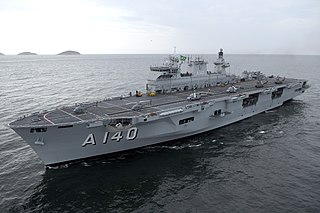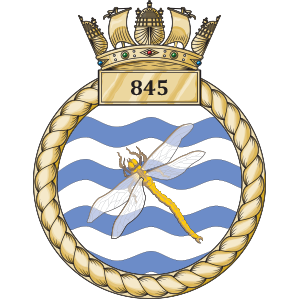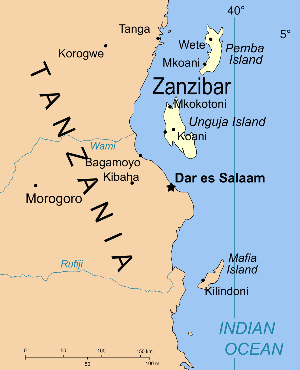
Zanzibar is an insular semi-autonomous province which united with Tanganyika in 1964 to form the United Republic of Tanzania. It is an archipelago in the Indian Ocean, 25–50 km (16–31 mi) off the coast of the African mainland, and consists of many small islands and two large ones: Unguja and Pemba Island. The capital is Zanzibar City, located on the island of Unguja. Its historic centre, Stone Town, is a World Heritage Site.

HMS Albion is an amphibious transport dock of the Royal Navy, the first of the two-ship Albion class. Built by BAE Systems Marine in Barrow-in-Furness, Albion was launched in March 2001 by the Princess Royal. Her sister ship, Bulwark, was launched in November 2001, also from Barrow. Affiliated to the city of Chester and based in Plymouth, she is the ninth ship to carry the name Albion, stretching back to the 74-gun 1763 warship, and last carried by an aircraft carrier decommissioned in 1973 after 19 years service. Designed as an amphibious warfare ship, Albion carries troops, normally Royal Marines, and vehicles up to the size of the Challenger 2 main battle tank. She can deploy these forces using four Landing Craft Utility (LCUs) and four Landing Craft Vehicle and Personnel (LCVPs). A flight deck supports helicopter operations.

Landing platform helicopter (LPH) is a term used by some navies to denote a type of amphibious warfare ship designed primarily to operate as a launch and recovery platform for helicopters and other VTOL aircraft. As such, they are considered a type of helicopter carrier.

Amphibious warfare is a type of offensive military operation that today uses naval ships to project ground and air power onto a hostile or potentially hostile shore at a designated landing beach. Through history the operations were conducted using ship's boats as the primary method of delivering troops to shore. Since the Gallipoli Campaign, specialised watercraft were increasingly designed for landing troops, material and vehicles, including by landing craft and for insertion of commandos, by fast patrol boats, zodiacs and from mini-submersibles. The term amphibious first emerged in the United Kingdom and the United States during the 1930s with introduction of vehicles such as Vickers-Carden-Loyd Light Amphibious Tank or the Landing Vehicle Tracked.

Seif Sharif Hamad was a Tanzanian politician who served as the First Vice President of Zanzibar and as Party Chairman of ACT Wazalendo.

The Zanzibar Revolution occurred in January 1964 and led to the overthrow of the Sultan of Zanzibar and his mainly Arab government by the island's majority Black African population.
John Gideon Okello was a Ugandan revolutionary and the leader of the Zanzibar Revolution in 1964. This revolution overthrew Sultan Jamshid bin Abdullah and led to the proclamation of Zanzibar as a republic.

845 Naval Air Squadron is a squadron of the Royal Navy's Fleet Air Arm. Part of the Commando Helicopter Force, it is a specialist amphibious unit operating the AgustaWestland Commando Merlin HC4 helicopter and provides troop transport and load lifting support to 3 Commando Brigade Royal Marines. In 2012, the squadron celebrated 50 years since it was awarded "commando" status.

Abeid Amani Karume International Airport is the main airport in the Zanzibar Archipelago located on Unguja Island, Zanzibar, Tanzania. It is approximately 5 kilometres (3.1 mi) south of Zanzibar City, the capital of Zanzibar, and has flights to East Africa, Europe, and the Middle East. It was previously known as Kisauni Airport and Zanzibar International Airport. It was renamed in 2010 in honour of Abeid Amani Karume, the island's first president.

The Sultanate of Zanzibar, also known as the Zanzibar Sultanate, was a Muslim state controlled by the Sultan of Zanzibar, in place between 1856 and 1964. The Sultanate's territories varied over time, and after a period of decline, the state had sovereignty over only the Zanzibar Archipelago and a 16-kilometre-wide (10 mi) strip along the Kenyan coast, with the interior of Kenya constituting the British Kenya Colony and the coastal strip administered as a de facto part of that colony.
Abdulrahman Mohamed Babu was a Zanzibar-born Marxist and pan-Africanist nationalist who played an important role in the 1964 Zanzibar Revolution and served as a minister under Julius Nyerere after the island was merged with mainland Tanganyika to form Tanzania. He was jailed by Nyerere from 1972 and, after his release following an international campaign, remained a vocal critic of imperialism, authoritarian states and excessively statist development models.
People have lived in Zanzibar for 20,000 years. History properly starts when the islands became a base for traders voyaging between the African Great Lakes, the Somali Peninsula, the Arabian peninsula, Iran, and the Indian subcontinent. Unguja offered a protected and defensible harbor, so although the archipelago had few products of value, Omanis and Yemenis settled in what became Zanzibar City as a convenient point from which to trade with towns on the Swahili Coast. They established garrisons on the islands and built the first mosques in the African Great Lakes Region.

An amphibious assault ship is a type of amphibious warfare ship employed to land and support ground forces on enemy territory by an amphibious assault. The design evolved from aircraft carriers converted for use as helicopter carriers. Modern ships support amphibious landing craft, with most designs including a well deck. Coming full circle, some amphibious assault ships also support V/STOL fixed-wing aircraft, now having a secondary role as aircraft carriers.

Operation Parthenon was a British plan for military intervention in Zanzibar following the 1964 revolution. The operation was authorised by the British Commanders Committee East Africa on 30 January. The main objectives were to restore law and order in Zanzibar and to prevent the radical left-wing Umma Party from taking control of the government from the moderate Afro-Shirazi Party. The forces assigned to the operation included two aircraft carriers, three destroyers, a Royal Fleet Auxiliary vessel, 13 helicopters, 21 transport or reconnaissance aircraft, a battalion of Foot Guards, a battalion of Royal Marines and an independent company of paratroopers. The plan was to launch a helicopter and parachute assault of Unguja, Zanzibar's main island, before proceeding to take the smaller island of Pemba. If it had been carried out, Parthenon would have been the largest British airborne and amphibious operation since the Suez Crisis of 1956. Parthenon was scrapped around the 20 February and replaced with Operation Boris.

Operation Boris was a British plan for military intervention in Zanzibar following the 1964 revolution. It was devised around 20 February to be used if the radical left-wing Umma Party attempted to take power. It replaced the earlier sea-based Operation Parthenon with a parachute assault launched from Kenya. However the operation was not required and was jeopardised by the lack of co-operation from the Kenyan government and populace for an attack on Zanzibar. Boris was replaced by Operation Finery, an amphibious helicopter assault, on 9 April 1964.

Operation Shed was a British plan for military intervention in Zanzibar following the 1964 Zanzibar revolution. It was one of a series of operations devised by the British to be implemented in the case of an attempt to seize power from President Abeid Karume by the radical left-wing Umma Party. Shed succeeded the earlier Operations Parthenon and Boris and was an alternative to Operation Finery. Shed would have involved an airlift of a battalion of troops to Unguja to provide support to Karume and to protect European citizens. The risk of a coup passed by 29 April 1964 and it was determined that any intervention would be opposed by Karume's forces and a Soviet training team. With this in mind Shed was modified on 9 June to an airborne assault by Royal Marine commandos from HMS Centaur, which would then be supported by the landing of a battalion and armoured cars from Kenya. The continuing presence of British and friendly nationals in Zanzibar complicated the matter and, around 23 September 1964, Shed was replaced by Plan Giralda.

Plan Giralda was a British plan for military intervention in Zanzibar following the 1964 revolution. Giralda was intended to be launched if the radical left-wing Umma Party attempted to launch a coup against the government of President Julius Nyerere's newly formed Tanzania. It was the fifth and final British plan for such an eventuality, following Operations Parthenon, Boris, Finery and Shed. Giralda would have required British Army units, Royal Marines and Royal Navy vessels from the Far East to be deployed to Zanzibar if a request was received from Nyerere. Follow on units would be sent after the main assault from the British garrison in Kenya. The operational constraints of sending troops over such long distances, the reluctance of the Kenyan government to weaken the British presence in their country, the reduction of Western presence in Zanzibar and the strengthening of the political situation in Tanzania made intervention unlikely and the plan was suspended in October 1964. The newly elected Labour government cancelled the plan in December.

Operation Vantage was a British military operation in 1961 to support the newly independent state of Kuwait against territorial claims by its neighbour, Iraq. The UK reacted to a call for protection from Sheikh Abdullah III Al-Salim Al-Sabah of Kuwait, and air, sea and land forces were in place within days. Iraq did not attack and the British forces were replaced by the Arab League. Iraq recognised Kuwaiti independence in 1963.

The People's Republic of Zanzibar was a short-lived African state founded in 1964, consisting of the islands of the Zanzibar Archipelago. It existed for less than a year before it merged with Tanganyika to create the United Republic of Tanganyika and Zanzibar, which would be renamed to Tanzania in October of that year.

The Joint Expeditionary Force (Maritime) (or JEF(M)) (formerly the Response Force Task Group (RFTG), and prior to that the Joint Rapid Reaction Force (JRRF)), is the Royal Navy's contribution to the UK Joint Expeditionary Force (JEF) maintained at very high-readiness and available at short notice to respond to unexpected global events. In addition to the Royal Navy and the Royal Marines, the JEF(M) also includes elements of the British Army and the Royal Air Force. While it is primarily poised to conduct war-fighting or strike operations, the JEF(M) is capable of undertaking a diverse range of activities such as evacuation operations, disaster relief or humanitarian aid.













